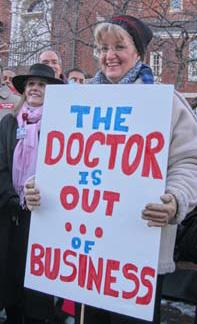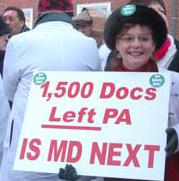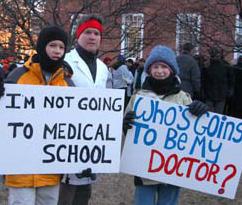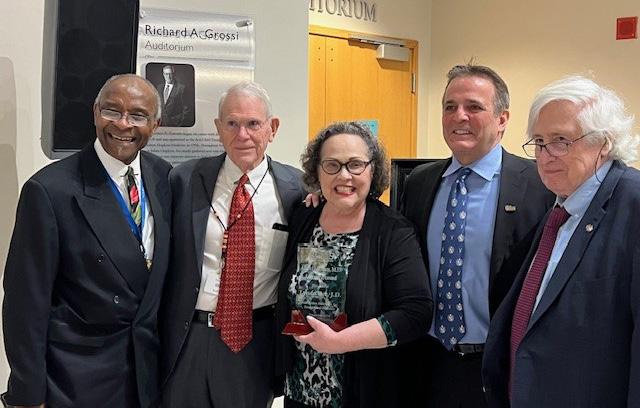





























The House of Medicine is called on to address a critical issue affecting both physicians and patients in Maryland: the proposed repeal of the cap on non-economic damages. While the current proposal does not include health care or medical malpractice cases, the lawyers have made it clear health care is next.
MedChi is opposing the repeal of the general cap to protect the future attacks and because the noneconomic damages health care cap is so important to stability in the Maryland market.
MedChi staunchly opposes the repeal of the non-economic damages cap on health care, as it threatens to destabilize our health care system, escalate costs, and ultimately compromise patient care.
Non-economic damages refer to compensation for intangible losses such as pain, suffering, and emotional distress, distinct from economic damage that covers quantifiable losses such as medical bills and lost wages. Currently, Maryland enforces a cap on these non-economic damages set at $890,000, with an annual increase of $15,000. This cap serves as a safeguard, ensuring patients receive fair compensation yet keeping the awards within reasonable limits.
Eliminating the cap on non-economic damages would have farreaching negative consequences:
1. Escalation of Health Care Costs: Without a cap, malpractice insurance premiums are likely to surge due to the unpredictability of jury awards. These increased operational costs could translate into higher health care expenses for patients.
2. Physician Workforce Challenges: Rising insurance premiums may compel physicians, especially those in high-risk specialties like obstetrics and surgery, to relocate to states with more stable liability environments or to retire early. This potential exodus would exacerbate the existing physician shortage in Maryland, limiting patient access to essential medical services.
3. Impact on Patient Care: The financial strain from heightened liability risks might force health care providers to reduce services, particularly in underserved areas. Consequently, patients could face longer wait times and diminished access to specialized care.
MedChi remains unwavering in its commitment to preserving the cap on non-economic damages. We actively engage with legislators, providing data-driven insights to highlight the potential repercussions of the cap’s repeal. Our advocacy efforts are rooted in the belief that a stable medical liability environment is essential for the sustainability of health care practices and the well-being of patients.
I urge our members to join us in this advocacy. By presenting a unified front, we can effectively communicate the importance of maintaining the current cap to policymakers, ensuring that Maryland’s health care system remains robust and capable of delivering high-quality care to all residents.
— Padmini Ranasinghe, MD MedChi President
1. Jennifer Christie, MD, head of the Division of Gastroenterology and Hepatology at the University of Colorado Department of Medicine will be speaking with Stephen Rockower, MD, for MedChi’s first podcast of 2025, which launches later this month! Tune in to MedCast on Spotify, Apple Podcasts, and Audible. Previous guests include Senator Clarence Lam, MD, State Senator District 12; Howard Haft, Executive Director of the Maryland Primary Care program; and Corey Feist, Co-Founder of the Dr. Lorna Breen Heroes’ Foundation.
2. MedChi’s Spring House of Delegates meets virtually on Sunday, April 27, at 8:00 a.m. For details contact Jenine at JFeaster@medchi.org.
3. Maryland Assembly’s session continues in Annapolis through April 7. Please help MedChi amplify your voice by responding to alerts for action on certain bills. Locate your legislators through MedChi’s Legislative Center and send a formatted email through this system, making it easy to be a grassroots activist.
4. March is National Colorectal Cancer Awareness Month. Help us spotlight colorectal cancer and inspire more people to get checked starting at age forty-five.
Alexis R. Braun, Esq.

In response to excessive and disproportionate jury awards, the General Assembly in 1986 enacted a cap on noneconomic damages, imposing reasonable limits on the amount that can be awarded in medical liability and other personal injury cases. This legislation added a measure of predictability and stability to Maryland’s civil justice system. A review of the history of Maryland’s cap on noneconomic damages reminds us that damages caps are just as crucial today as they were when enacted nearly forty years ago.
Introduction of the Cap
In the 1980s, there was increasing attention focused on the availability and affordability of liability insurance, including medical professional liability insurance. Medical professional liability insurance premiums were rising, with obstetricians, neurosurgeons, and other higher-risk specialists experiencing increases ranging from 30 to 350 percent nationally.
According to a 1985 report by the Center for Health Policy Research at the American Medical Association, “estimates suggest that costs generated by the current liability system were responsible for between 14.5 and 17.6 percent of the $65.4 billion spent on physicians’ services in the United States in 1984.”1 A 1986 report by a Tort Policy Working Group established by the U.S. Attorney General noted “the extraordinary growth over the last decade of the number of tort lawsuits and the average award per lawsuit.”2 The report also noted that the number of medical liability lawsuits “doubled between 1979 and 1983, and tripled during that period for obstetricians/gynecologists” and that, “between 1975 and 1985, the average medical liability jury verdict increased from $220,018 to $1,017,716.”
Increasing attention on the issue led to action, and several task forces in Maryland studied the issue. After two reports in December 1985 recommended imposing a $250,000 limit on noneconomic damages, Senate Bill 558 was introduced in the 1986 Session of the Maryland General Assembly.
A hearing on the bill was held on February 11, 1986, in the Senate Judicial Proceedings Committee. Numerous physicians
testified in the hearing, signed statements of support for the bill, and sent letters to members of the Senate asking for favorable passage of the bill. In one letter, an ophthalmologist aptly framed the issue: “There has been an overwhelming amount of gross abuse of the legal system as it now stands. We are concerned not only about the overall cost to the patient, but even more particularly about the erosion of the doctor–patient relationship. These days it is very difficult to see a patient without viewing him as a potential plaintiff. Defensive medicine is adding to the ever increasing costs of health care in this country.”
On March 12, 1986, the Senate passed Senate Bill 558. Following several amendments, the bill became law, establishing a $350,000 cap on noneconomic damages in all personal injury cases, including medical liability cases.
Following passage of the bill, the General Assembly revised the noneconomic damages cap. In 1989, the General Assembly prohibited juries from being informed of the cap and required courts to reduce a jury award in excess of the cap to the amount of the cap. In 1994, the General Assembly made the cap applicable to wrongful death actions, raised the cap from $350,000 to $500,000, and added an “escalator,” which automatically increases the cap by $15,000 on October 1 of each year.
In the 2004 Session, Governor Ehrlich introduced crossfiled bills (the Maryland Injury Compensation Reform Act) in response to concerns about the rising costs of medical professional liability insurance premiums and the impact of those costs on access to and the quality of health care in Maryland. After the bills received unfavorable reports in their respective committees, Senate President Miller formed the Senate Special Commission on Medical Malpractice Liability Insurance, which released its report in December 2004. A special session was convened on December 28, 2004, to address the Special Commission’s recommendations, and the General Assembly enacted emergency legislation known as the Maryland Medical Professional Liability Insurance Rate Stablization Act of 2004, which separated the cap on noneconomic damages into two discrete caps: one applicable to medical liability cases and another applicable to general personal injury or wrongful death cases (e.g., motor vehicle accidents).
continued on page 14

MedChi members gathered at Acqua Al Due in the heart of Annapolis on January 13, 2025, to celebrate the “kick off” of the 447th session of the Maryland General Assembly.





Editorial Offices: MedChi, The Maryland State Medical Society; 1211 Cathedral Street, Baltimore, MD 21201; 410.878.9897
Advisory Board: Bruce M. Smoller, MD (Chair); Stephen J. Rockower, MD (Vice Chair); Gene Ransom, III, Esq (CEO, MedChi); Susan G. D’Antoni (MedChi Director of Publications); Susanna M. Carey (Production Editor)
Managing Editor: Victoria Hecht, 410.878.9897; vhecht@medchi.org
Advertising: Victoria Hecht, 410.878.9897; vhecht@medchi.org




All opinions and statements of supposed fact expressed by authors are their own, and not necessarily those of Maryland Medicine or MedChi. The Advisory Board reserves the right to edit all contributions, as well as to reject any material or advertisements submitted.
Copyright © 2025. Maryland Medicine, The Maryland Medical Journal. USPS 332080. ISSN 1538-2656 is published by the Medical and Chirurgical Faculty of Maryland, 1211 Cathedral Street, Baltimore, Maryland 21201, and is a membership benefit.
All rights reserved. No portion of this journal may be reproduced, by any process or technique, without the express written consent of the publisher. Advertising in Maryland Medicine does not imply approval or endorsement by MedChi unless expressly stated.
DISCLAIMER: Some articles may contain information regarding general principles of law. They are not intended as legal advice and cannot be substituted for such. For advice regarding a specific legal situation, consult an attorney licensed in the applicable jurisdiction and with appropriate training and/or experience in the legal area in question.
Wes Cleveland, JD, and Allen Hardiman, PhD


After years of relative quiet — at least in comparison with the crisis of the early 2000s, medical liability is becoming an advocacy priority for many in organized medicine. One reason is the dramatic rise of “nuclear” jury verdicts (verdicts of at least 10 million dollars). According to the Doctors Company, citing data from Transre, from 2013 to 2023, nuclear verdicts increased by 67 percent and in 2023 more than half were over $25 million. In 2023, the average of the highest 50 medical liability verdicts grew 50 percent to $48 million each from $32 million each in 2022.1 Another major cause for concern is a renewed push to eliminate or weaken existing medical liability reforms.
Several factors are contributing to the rise of jury awards and an environment conducive to legislative attempts to undermine medical liability protections. One significant factor may be the erosion of public trust in the U.S. health care system in the wake of the COVID pandemic. According to a widely cited survey study involving 443,455 respondents, trust in physicians and hospitals decreased substantially over the course of the pandemic, from 71.5 percent in April 2020 to 40.1 percent in January 2024.2 This lack of trust may have lowered the esteem that jurors had held physicians and thus be less reluctant to find liability.
New plaintiff attorney tactics are also a factor. One example is the “reptile” strategy. Here the plaintiff’s attorney tries to trigger a “fight or flight” response that is ingrained in primitive parts of the human brain (hence the use of “reptile”). The goal is to obtain an outsized verdict by getting the jury to view the physician’s alleged conduct not only as affecting an individual plaintiff, but also as a violation of “safety rules” that threatened the safety of the jurors’ community.
A second strategy are highly speculative “life care plans” that may come into play in cases involving a patient that has suffered a disability. Life care plans were intended to help a jury (assuming the jury finds liability) determine how much the plaintiff needs to be awarded based on the projected costs of the
future, real, medical treatment, rehabilitation, transportation, modification of his or her residence unless the plaintiff requires long-term care, activities of daily living, etc. However, in some cases life care plans are being used in spurious ways that greatly exaggerate the projected care and support that the plaintiff will actually require. Even though their projection of future care may have little connection to reality, they can lead a jury to award damages that are grossly in excess of the costs for medical care, etc., that the plaintiff will really need in the future.
“Anchoring” is another well-known strategy. When employing the anchoring tactic, the plaintiff’s attorney asks the jury to render non-economic damages that the attorney knows full well are far higher than what the jury will award. This is designed to create “anchor bias” so that, when deciding how much to award in non-economic damages, the jury make its decision in reference to that requested by the plaintiff’s attorney, leading to damage amounts much higher than they might otherwise be if an honest amount were the standard.
Changes in jurors are also contributing to exaggerated verdicts, sometimes referred to as “social inflation.” The following are just a few examples. The decline in public perceptions of the post-Covid health care system is one, as well as the feeling that corporations have taken over health care. Further, jurors have grown so accustomed to large numbers, e.g., huge jury verdicts, salaries of sports figures, media personalities, etc., that they may think nothing of rendering multi-million-dollar verdicts. Juries may also award outsized verdicts in an effort to address broader societal or political issues.
Social inflation helped create a climate conducing invigorated efforts aimed at eliminating or weakening tort reform laws. One notable effort is the return of ballot initiatives. In 2022, a ballot initiative was filed that would have gutted the California’s Medical Injury Compensation Reform Act (MICRA). MICRA, enacted in 1975, has been the AMA’s gold standard for medical liability reform for many years, including a $250,000 cap on non-economic damages. The California Medical Association (CMA) and others played a key role in negotiations that resulted in the ballot initiative’s withdrawal while also updating and retaining MICRA’s essential components. In 2024, trial lawyers in Colorado filed two ballot measures that would have eliminated Colorado’s cap on non-economic damages and peer review confidentiality protections. Colorado Medical Society
on page 18

Gene Ransom III, CEO, MedChi

For over two centuries, MedChi has been at the forefront of protecting Maryland physicians from harmful legal changes that threaten the stability of the medical profession. By vigorously opposing legislation aimed at dismantling contributory negligence protections, raising the cap on noneconomic damages, and weakening expert witness safeguards, MedChi continues to fight for a fair legal environment that allows health care professionals to focus on patient care.
During the 2024 Maryland General Assembly Session, MedChi successfully blocked two major tort bills that posed significant threats to the legal framework surrounding medical practice.
House Bill 83/Senate Bill 538: Civil Actions – Noneconomic Damages – Personal Injury and Wrongful Death (Failed)
This bill sought to repeal the cap on noneconomic damages — pain and suffering — awarded in negligence cases. Although the legislation did not directly apply to health care claims, its passage would have set a dangerous precedent and paved the way for future attacks on the noneconomic cap applicable to medical malpractice cases.
Following a spirited debate on the Senate floor, the bill passed with amendments, which would have increased the cap to $1.75 million for personal injury and $2.625 million for wrongful death involving two or more claimants, with an annual $20,000 increase. MedChi opposed the bill due to the negative implications it could have for the medical community. Thanks to our advocacy, the bill ultimately failed to receive a vote in the House.
House Bill 1361: Task Force to Study Various Aspects of Changing Contributory Negligence to Comparative Negligence Act (Failed)
This bill proposed studying a shift from Maryland’s current contributory negligence standard—which bars plaintiffs from recovering damages if they bear any responsibility for their injuries—to a comparative negligence system, which apportions fault between plaintiffs and defendants. MedChi strongly supports maintaining the contributory negligence standard.
Jeffrey Chung, MD, a MedChi member and ophthalmologist, played a pivotal role in defeating this bill. His established relationship with the bill sponsor enabled him to communicate MedChi’s concerns effectively. As a result, the legislation was withdrawn. This defeat is a perfect example of the importance of personal connections between physicians and legislators.
Past Victories in Defense of Expert Witness Protections
In recent years, MedChi successfully opposed attempts to dismantle Maryland’s expert witness rules, which protect against the use of “professional witnesses.”
Senate Bill 30/House Bill 1581: Health Care Malpractice
Qualified Expert – Limitation on Testimony in Personal Injury Claims (Failed)
This bill aimed to repeal the “20% Rule,” which limits standard of care experts from spending more than 20% of their professional time testifying as expert witnesses. This rule is essential for preventing the proliferation of career expert witnesses whose primary function is to testify in court rather than practice medicine.
Despite initial passage in the Senate, the bill faced significant hurdles in the House, where amendments addressed concerns about experts becoming disqualified due to retirement, illness, or changes in practice. The Senate rejected these amendments, and a conference committee ultimately recommended reverting to the bill’s original form—a full repeal of the 20% Rule.
MedChi mounted an intense lobbying campaign, and although the bill narrowly passed in the Senate by just one vote, it was defeated in the House by a resounding 41-89 vote. This victory underscored MedChi’s critical role in protecting the integrity of Maryland’s medical liability system.
The Importance of Physician Advocacy
These successes are a testament to the power of organized advocacy and the importance of strong relationships between physicians and lawmakers. MedChi’s continued efforts to safeguard tort protections are crucial for ensuring that Maryland remains a state where physicians are able to practice without the constant threat of legal jeopardy.
We encourage all physicians to engage with MedChi and their local legislators to strengthen these vital relationships. Together, we can continue to defend the medical profession and promote a fair and just legal environment for health care providers and patients alike.
Gene Random III is CEO of MedChi, The Maryland State Medical Society.
Gene Ransom III, CEO, MedChi
MedChi, The Maryland State Medical Society, in collaboration with Medical Mutual, has submitted an amicus curiae brief in the case Canton Harbor Healthcare Center, Inc. v. Robinson before the Supreme Court of Maryland. MedChi files two to three amicus briefs each year as a friend of the court to protect physicians and advocate for the interests of its members. These legal interventions help ensure that court decisions support the integrity of medical practice and uphold fair standards for expert testimony.
The Robinson case centers on allegations of medical malpractice involving pressure ulcer injuries at a nursing home facility. One of the key legal questions before the court is whether a registered nurse may serve as a qualified expert to offer opinions on medical standards of care, specifically regarding the development of pressure ulcers. The case also raises questions about whether federal regulations governing Medicare and Medicaid funding for nursing facilities should influence the qualifications of health care professionals to provide expert testimony. The potential departure from current law reserving medical diagnoses to physicians raises significant questions about the role and authority of registered nurses in current and future health care litigation.
The case further exemplifies how lawyers often use the courts to test and potentially change existing laws. By bringing cases like Robinson, attorneys seek judicial decisions that could reshape scope of practice rules and redefine professional boundaries in health care. This tactic has long been a strategy for legal advocates aiming to drive policy changes through judicial precedents rather than legislative action.
MedChi’s decision to join the amicus brief underscores MedChi’s concern about the broader implications this case may have for both medical malpractice jurisprudence and scope of practice boundaries within Maryland. Allowing registered nurses to opine on medical standards of care risks blurring the professional roles that are carefully defined to protect patient care standards.
By joining Medical Mutual in this legal effort, MedChi continues its longstanding advocacy for maintaining the integrity of medical practice and ensuring that expert testimony in health care–elated cases remains within the appropriate professional scope.
For additional information, please refer to the MedChi amicus brief filed with the Supreme Court of Maryland on Dec. 4, 2024.
Greg Viccica
Medical malpractice insurance protects health care providers from the financial and professional consequences of malpractice claims. Without this coverage, legal fees, court costs, settlements, and judgments — often reaching hundreds of thousands or even millions of dollars — would have to be paid out-of-pocket, potentially leading to financial ruin. Beyond financial protection, malpractice insurance helps safeguard a provider’s reputation. A single lawsuit, even if unfounded, can damage the trust and credibility built with patients and the community. Proper coverage ensures that providers can defend themselves against claims while maintaining their ability to deliver care.
By defending claims and deterring frivolous lawsuits, strong medical malpractice insurance provides stability for healthcare practices and the system. When plaintiffs know a carrier will fight, they are less likely to pursue baseless claims. This protection ensures that providers can focus on patient care without the threat of litigation disrupting their practice.
Medical malpractice insurance provides coverage for a wide range of potential claims, including misdiagnoses (a patient may claim their condition was incorrectly diagnosed, leading to delayed or improper treatment); treatment errors; and poor medical advice (patients may allege that incorrect guidance contributed to worsening health conditions). In each of these situations, a comprehensive malpractice insurance policy covers legal defense costs, settlements, or judgments, preventing devastating financial losses.
There are two main types of medical malpractice insurance: claims-made and occurrence-based. Claims-made policies cover claims filed while the policy is active, requiring tail coverage when switching insurers or retiring. Occurrence-based policies cover incidents that happen during the policy period, regardless of when claims are filed, eliminating the need for tail coverage. Claims-made policies are more common and initially cheaper, while occurrence policies have higher but steady premiums.
on page 16

Maryland’s Cap..., continued from pg. 3
Medical Malpractice Insurance, continued from pg. 11 Where the Cap Stands Now
As of January 1, 2025, the cap on noneconomic damages in medical liability cases is $905,000 for personal injury and $1,131,250 for wrongful death involving two or more claimants or beneficiaries.
Since 1994, the Maryland General Assembly has considered numerous bills seeking to modify the noneconomic damages caps for medical liability and general liability cases, including attempts to raise or alter the caps or repeal the caps entirely. In the current session of the General Assembly, House Bill 113 and Senate Bill 584 have been introduced to repeal the cap on noneconomic damages in general liability cases. Although these bills do not directly affect the cap on noneconomic damages in medical liability cases, a repeal of the noneconomic damages cap in general liability cases will likely open the floodgates to judicial challenges that seek to invalidate the noneconomic damages cap applicable to medical liability cases.
A plaintiff who has proven negligence to a jury is entitled to compensation. However, pain and suffering and other noneconomic damages are inherently subjective and unquantifiable. Well aware of that reality, Maryland’s lawmakers nearly 40 years ago enacted caps on noneconomic damages. In cases of medical liability, the noneconomic damages cap recognizes the need for plaintiffs to be fairly compensated for their loss while also recognizing the need to protect physicians from the risk of unlimited damage awards. The cap allows Maryland Physicians to deliver quality care and avoid seeing each of their patients as a “potential plaintiff.”
So much has changed since 1986, but the reasons for keeping the current caps in place have not. Medical Mutual stands with MedChi and all Maryland Physicians in opposing any attempts to repeal or weaken the noneconomic damages caps.
Alexis R. Braun, Esq., is an Assistant Vice President and Associate General Counsel for Medical Mutual Liability Insurance Society of Maryland
Liability laws vary from state to state. Scan the codes below to learn about medical liability laws in your state and across the country.


Medical malpractice laws vary significantly from state to state. Unlike other states, Maryland does not mandate physicians to carry malpractice insurance. However, those without coverage must notify new patients in writing — a disclosure that could influence a patient’s decision when choosing a doctor.
Many physicians mistakenly believe that malpractice insurance is prohibitively expensive, but premiums are primarily determined by factors such as specialty, experience, and claim history. One of the biggest cost factors is the state in which the physician practices. According to Chris Harrop of MGMA, nearly 70 percent of medical groups nationwide have seen increases in malpractice premiums. Thankfully in Maryland most providers have not faced significant rate hikes in recent years. To manage these costs, many individual providers are joining larger practices that offer coverage — often at the cost of some autonomy in practice management.
Another complex law that varies from state to state is the misconception that offering an apology to a patient could prevent a lawsuit. In Maryland, physicians are allowed to express sympathy to patients or their families, but any admission of fault is not protected under the law. Navigating these nuances is vital for maintaining patient relationships and legal protection.
While no one can predict the future, having malpractice insurance does provide peace of mind. Legal battles are costly, even if a claim is ultimately dismissed. Defense expenses can escalate quickly, especially given the lengthy nature of malpractice litigation. Without insurance, independent practitioners and smaller practices may struggle to absorb these costs. Malpractice insurance is a worthwhile investment in your career, your practice, and your peace of mind.
Greg Viccica is the Marketing Operations Specialist at Unity Insurance and may be reached at Greg@unityinsurance.co.

Medical Liability, continued from pg. 7 (CMS) and allies were successful in reaching a compromise that maintains liability caps and preserves peer review. Reaching these compromises also helped CMA and CMS to avoid costly ballot fights. It would not be surprising if other states saw similar ballot initiatives.
There is an upward trend in legislative efforts to weaken wrongful death laws by increasing caps and/or expanding the types of individuals who can sue a for wrongful death. For example, in late December 2024, New York Governor Hochul vetoed for the third-year legislation that would have increased physicians’ and others’ liability exposure under the state’s wrongful death statute. Governor Hochul vetoed the legislation in part because it “would increase already high insurance burdens on families and small businesses and further strain already-distressed healthcare workers and institutions” which would be “particularly challenging for struggling hospitals in underserved communities.” Other states have seen wrongful death activity—since 2023, New Hampshire, Maine, New Jersey, and Rhode Island have raised their cap on non-economic damages or expanded the class of individuals who may bring a wrongful death lawsuit. Other trends include prejudgment interest on judgments, statutes of limitation, collateral source, and attempts to deal with “phantom damages.” While little if any medical liability legislation has yet to be enacted, rest assured that the AMA very closely monitors any legislative medical liability proposals that impact physicians and is always ready to help organized medicine.
The increase in the size of jury verdicts and attempts to roll back liability protections may be a reason why we appear to be entering a “hard market” with respect to medical liability insurance premiums. A 2023 AMA Policy Research Perspectives found, for the fourth year in a row, a prevalence of medical liability insurance premium increases that has not been seen since 2000s.3 The AMA plans to publish an update to this Policy Research Perspectives in 2025. The AMA will also be updating the 2024 version of “Medical Liability Reform –Now!”4
While organized medicine is facing new medical liability challenges, both legal and non-legal, e.g., social inflation, organized medicine can defeat or mitigate legislative challenges as well as promote its own initiatives. The AMA has many resources that can help organized medicine, e.g., model bills, fifty-state surveys, etc. An exciting new resource is the “Your Care is at Our Core” campaign, which is intended to strengthen the bond between physicians and patients. This campaign is a collaborative advocacy effort involving the AMA and select state medical societies, and sometimes, medical
liability insurers, and MedChi is one of the first state medical associations participating in the campaign.5 The AMA and MedChi stand together in advocating for physicians, whether the issue is medical liability or other organized medicine’s advocacy priorities..
As expected, bills addressing the gamut of medical liability reforms have been introduced in state legislatures and the AMA tracks these bills very closely and is available to work with its partners in organized medicine wanting to engage in medical liability advocacy.
Wes Cleveland is the Senior Attorney for the American Medical Association (AMA). Allen Hardiman, PhD, is a Senior Economist at the AMA.


Allan D. Jensen, MD (pictured right), former president of Baltimore City Medical Society and MedChi, has long championed the need for advocacy efforts to benefit the profession of medicine and patient care.
In recognition of Dr. Jensen’s ongoing commitment to local and state advocacy efforts, BCMS board of directors established the Allan D. Jensen, MD, Advocacy Award. The inaugural Award was presented to Lynda Dee, JD, co-founder of AIDS Action Network in Baltimore.
Despite the snowfall on the afternoon of February 11, more than twenty Maryland physicians headed to Capitol Hill to lobby all ten members of the Maryland Congressional delegation to talk with them about senior patients’ access issues. The Hill visits were coordinated by MCMS’ CEO Susan D’Antoni on behalf of MedChi and in conjunction with the AMA’s National Advocacy Conference, which was attended by physician advocates from every state.
Of greatest importance was requesting co-sponsorship of HR 879, the Medicare Patient Access and Practice Stablization Act, which is a bipartisan effort to address the 2.83 percent Medicare cut and provide a 2 percent update before midMarch when the budget for the year is approved. This legislation would prospectively cancel the physician payment cut that took effect January 1, and would take effect on April 1. The measure has already gathered sixty-three bipartisan cosponsors.
During Maryland physicians’ visits, most of Maryland’s elected officials were supportive of this legislation, and three new cosponsors were enlisted, including Rep. Steny Hoyer, Rep. Glenn Ivey, and Rep. Johnny Olszewski. Representative Andy Harris, MD, was already a co-sponsor.

Barton Gershen, MD†
This article originally appeared in the Spring, 2005 issue of Maryland Medicine
The subject of tort reform is on President Bush’s political agenda, as it has been on medicine’s for many years. A tort is an injurious or wrongful act involving liability, for which a civil suit may be instituted. The term derives from Latin torquere: “to twist,” the past participle of which is tortum. It suggests that the tables have been turned (twisted) on the defendant, and the court will provide a redress for the plaintiff’s grievances. The term torque, a measure of a force’s tendency to produce torsion, also derives from torquere. Torsion may also be used for purposes of torture, as when arms are twisted beyond their normal limits of supination or pronation. (The infamous Tomas de Torquemado [1420-1498], the first Grand Inquisitor of Spain, tortured and burned at the stake thousands of Spanish Jews and Muslims who, though having nominally converted to Christianity, were still secretly practicing their own religions. Although “torque” is present in his name, it does not derive from the Latin “to twist.” His surname stems from his birthplace: Torquemado, a small town near the city of Valladolid in northern Spain. The name Torquemado derives from the Latin turris cremata: “burnt tower,” a historic landmark within his native village.)
Several words emanate from torquere (“to twist”) and its past participle tortum; words such as retort (a remark that is “twisted back” at an antagonist), contort and distort (methods of deforming or altering oneself, a speech, or a conversation), and extort (twisting something out of someone else’s possession).
A tornado (from Spanish tornar: “to turn,” which is derived, in turn, from Latin torquere) is literally a “twister,” and a torch was originally a light produced by twisting flammable material around the end of a stick and setting it on fire.
In ancient Rome flour was kneaded, rolled, and baked into a twisted bread called a torta, from which term we derive the torte–in this case, a rich cake made with many eggs and chopped nuts. Also from that Latin term torta, a baked disk of unleavened bread is known as a tortilla in Mexico. Furthermore, with but a slight alteration in spelling, the torte becomes a tart: “a small open pie with a sweet filling.” (This definition should also clarify the word’s slangy meaning for “prostitute.”)
A spasmodic contraction of the neck muscles, causing the head to be drawn to one side and the chin tilted to the opposite, is known as “wry neck” or torticollis (from Latin tortus: “twisted” and collum: “neck”). The Latin collum is evident in words such as collar and accolade (“an expression of approval”), the latter term deriving from the medieval knighthood ceremony in which the king taps the recipient on the neck with his sword and kisses his cheek.
South and west of Key West, Florida there is a long chain of coral islands extending into the Gulf of Mexico. They were discovered by the Spanish explorer Juan Ponce de Leon in 1513, who named the entire chain after the large tortoises that inhabited the tiny islands. In Spanish, turtles were known as tortugas, and since these islands were principally arid, sandy beaches, they have been called the Dry Tortugas. Tortoises were initially named from the Latin tartarucha: “arising in the underworld,” a vestige of an ancient Roman legend that attempted to explain the origin of these remarkable creatures. Tartarucha was subsequently modified by the Latin torquere, owing to the twisted shape of the animal’s feet. This ultimately established the Spanish term tortugas (“turtle”) and its English counterpart, tortoise. (Another Spanish word for tortoise is galapagos, a title bestowed on the volcanic islands located west of Ecuador, renowned for their giant tortoises, finches, flightless cormorants, and marine iguanas. The islands were made famous by Charles Darwin during his voyage on the Beagle in 1835.)
Small, low islands composed of coral or sand, such as those encompassing much of southern Florida, are also known in Spanish as quays—from which our anglicized term (Florida) Keys is derived. The outermost seven islands of the Dry Tortugas are largely uninhabited. Fort Jefferson National Monument, located on Garden Key within the Tortugas, is the largest all-masonry fort in the western hemisphere. It once served as a Union prison during and after the Civil War, and housed several of the alleged conspirators in the Lincoln assassination, including Dr. Samuel Mudd.
It was Dr. Mudd, you may recall, who admitted two men to his home near Bryantown, Maryland, at 4:00 A.M. on April 15, 1865. One of the men had a fractured left fibula. Dr. Mudd, an 1856 graduate of the University of Maryland School of Medicine and a general practitioner, set the traveler’s leg and ordered his handyman John Best to fashion a pair of crutches for the patient. The two strangers remained at Mudd’s home for another 12 hours, then departed on horseback for southern Virginia. Early in the morning of April 26, federal authorities trapped the two men in a barn at Garrett’s farm near Port Royal, Virginia. One of them surrendered, the other, the man with the fractured leg, refused to yield and was shot dead by a Sergeant Boston Corbett. The dead man was John Wilkes Booth who, two weeks previously, at 10:15 P.M. on the night of April 14, 1865, had shot president Abraham Lincoln in the back of the head.
continued on page 20
MedChi welcomes the following new members, who joined between January 1, 2025, and February 18, 2025.
Ahmed Abu-Haniyeh, MD — Tidal Health - EMPLOYED Physicians
Sara Acosta, MD — Mid-Atlantic Permanente Medical Group
Mavis Agyeiwaah, MD — Mid-Atlantic Permanente Medical Group
Arfa Ahmad, MD — Tidal Health - EMPLOYED Physicians
Ashish Ahuja, MD — Mid-Atlantic Permanente Medical Group
Jason Alan Smith, DO — Chesapeake Urology
Sunu Alexander, MD — Mid-Atlantic Permanente Medical Group
Nicole Alu, DO — Tidal Health - EMPLOYED Physicians
Neil Anjan Basumallik, MD — Tidal Health - EMPLOYED Physicians
John A. Appiott, DO — Tidal Health - EMPLOYED Physicians
Sabaina Arshad, MD — Mid-Atlantic Permanente Medical Group
Yaa Asante, MD — Mid-Atlantic Permanente Medical Group
Aaron Dominic Ates, MD — Tidal Health - EMPLOYED Physicians
Michael R. Atkins, MD — Tidal Health - EMPLOYED Physicians
Raheel Awan, MD — Mid-Atlantic Permanente Medical Group
Sandar Aye, MD — Tidal Health - EMPLOYED Physicians
Sandeep Bagla, MD — Chesapeake Urology
Zachary Baker, MD — Tidal Health - EMPLOYED Physicians
Rhondee Baldi, MD — Mid-Atlantic Permanente Medical Group
Letitia Banks, DO — Tidal Health - EMPLOYED Physicians
Tiffany Bell, MD — Mid-Atlantic Permanente Medical Group
Julie A. Berry, MD — Tidal Health - EMPLOYED Physicians
Salman Z. Bhat, MD — Tidal Health - EMPLOYED Physicians
William Bryan Bishop, III, DO — Emergency Service Associates, PA
Jerrold S. Canakis, MD — Tidal Health - EMPLOYED Physicians
Monica Chan, MD — Mid-Atlantic Permanente Medical Group
Lan Chang, MD — Mid-Atlantic Permanente Medical Group
Halim Charbel, MD — Tidal Health - EMPLOYED Physicians
Karan Chawdhary, MD — Mid-Atlantic Permanente Medical Group
Alexander Choi, MD — Mid-Atlantic Permanente Medical Group
Victoria Clark, MD — Mid-Atlantic Permanente Medical Group
Steven Cocciardi, MD — Mid-Atlantic Permanente Medical Group
Nicholas F. Colazzo, MD — Emergency Service Associates, P.A.
Salima Conteh, MD — Mid-Atlantic Permanente Medical Group
David Da Rocha-Afodu, MD — Mid-Atlantic Permanente Medical Group
Dalgis Dunker Del Rosario, MD — Mid-Atlantic Permanente Medical Group
Melissa Claire DeVito, MD — Tidal Health - EMPLOYED Physicians
Rajat Dhand, MD — Tidal Health - EMPLOYED Physicians
Max R. Drescher, MD — Chesapeake Urology
Sajid Ehsan, MD — Tidal Health - EMPLOYED Physicians
Eric R. Eidelman, MD — Chesapeake Urology
Simona C. Eng, DO — Tidal Health - EMPLOYED Physicians
Olabimpe Fashanu, MD — Evicore Healthcare
Elizabeth Fasika, MD — Tidal Health - EMPLOYED Physicians
Debebe Fikremariam, MD — Tidal Health - EMPLOYED Physicians
Cecily FitzGerald, MD — Mid-Atlantic Permanente Medical Group
Jacqueline Fleuriscar, MD — Mid-Atlantic Permanente Medical Group
Timothy Frazier, MD — Premier Orthopedics, P.A.
Liam Gaugh, MD — Mid-Atlantic Permanente Medical Group
Rewina Gebrechristos, MD — Mid-Atlantic Permanente Medical Group
Martha Getachew, MD — Mid-Atlantic Permanente Medical Group
Asma Ghafoor, MD — Mid-Atlantic Permanente Medical Group
Biswajit Ghosh, MD — Tidal Health - EMPLOYED Physicians
Steven L. Gibson, MD — Tidal Health - EMPLOYED Physicians
Frederick Goodwin Jr., MD — Mid-Atlantic Permanente Medical Group
Kwame Gyasi, MD — Patient First
Nicole Ha, DO — Mid-Atlantic Permanente Medical Group
Sarah Hall, MD — Mid-Atlantic Permanente Medical Group
Trudy R. Hall, MD — Tidal Health - EMPLOYED Physicians
Max Clayton Hamaker, MD — Chesapeake Ortho & Sports Medicine
Usaid Hasan, MD — Tidal Health - EMPLOYED Physicians
James Hatten, MD — Mid-Atlantic Permanente Medical Group
Pamela J. Howard, MD — Neurology Center
Tania L. Hudson, MD — Tidal Health - EMPLOYED Physicians
Miranda Hunter, MD — Mid-Atlantic Permanente Medical Group
Qamar Iqbal, MD — Tidal Health - EMPLOYED Physicians
Andrew Jacobs, MD — Tidal Health - EMPLOYED Physicians
Geetanjali Johri, MD — Tidal Health - EMPLOYED Physicians
Aser Kandil, MD — Tidal Health - EMPLOYED Physicians
Vijay Kumar Karumbunathan, MD — Tidal Health - EMPLOYED Physicians
Scott Kaufman, DO — Tidal Health - EMPLOYED Physicians
Rajwinder Kaur, MD — Mid-Atlantic Permanente Medical Group
Navneet Khaira, MD — Tidal Health - EMPLOYED Physicians
Ovais Khalid, MD — Tidal Health - EMPLOYED Physicians
Ahmad Khawaja, DO — Mid-Atlantic Permanente Medical Group
Arsalan Khawaja, MD — Mid-Atlantic Permanente Medical Group
Pankaj Kheterpal, MD — Charm City Healthcare LLC
Eric Daniel Klotz, DO — Emergency Service Associates, P.A.
Christopher Knaus, MD — Mid-Atlantic Permanente Medical Group
Gopal C. Kowdley, MD — Tidal Health - EMPLOYED Physicians
Matthew William Kramp, DO — Patient First
Justin Ryan Kucinski, DO — Tidal Health - EMPLOYED Physicians
Katherine L. Layton, MD — Tidal Health - EMPLOYED Physicians
Jeffrey Laczek, MD — Mid-Atlantic Permanente Medical Group
Thomas J. Lang, MD, PhD — Arthritis Care Specialists of Maryland
Alicia Lee, MD — Mid-Atlantic Permanente Medical Group
Ju Young Lee, MD — Mid-Atlantic Permanente Medical Group
Phung Levin, DO — Emergency Service Associates, P.A.
Sarah Lichenstein, MD — Mid-Atlantic Permanente Medical Group
The first mention of malpractice in Maryland was in 1655. Peter Sharp, chirurgeon (b. 1623, d.1672), sued Peter Godson, MD, for malpractice in killing a patient by “taking too much blood.” The case was referred to men of skill and ability to “judge the action.”
From its earliest days, working against quackery and pretenders to the medical arts has always been MedChi’s goal. “Few physicians among us are eminent for their skill. Quacks abound like locusts in Egypt. The profession is under no kind of regulation. We have no law to protect the lives of the King’s subjects from the malpractice of pretenders. Any man at his pleasure sets up for physician apothecary and chirurgeon. No candidates are either examined or licensed or even sworn to fair practice.” These words, from the Medical Annals of Maryland, are printed in the first section of the book, explaining why the Medical & Chirurgical Faculty of Maryland was originally founded. “Physicians” were practicing with no training and no regulation, and no recourse existed for patients who had been harmed.

Pictured above is a handwritten “lecture ticket.” In the early years of medical school, students purchased tickets to lectures on medicine, eventually garnering enough to become certified physicians.
Until 1765, there were no medical schools in America. Most educated physicians at the time studied at one of the medical schools in Europe. In 1765, the College of Medicine in Philadelphia began graduating students including John Archer, the first person to graduate from medical school in America, and one of MedChi’s founders. Other physicians studied medicine under the system of preceptorship, where a more experienced physician worked with a student to develop clinical skills, competence, and confidence.
Once MedChi established an examination system for physicians, and the number of physicians trained in medical schools increased, citizens became more confident in their medical care.
Meg Fairfax Fielding is the Director of the History of Maryland Medicine. She can be reached at mfielding@medchi.org
A complete list of MedChi and component events can be found at: http://www.medchi.org/Calendar-of-Events
MARCH
18: MedChi Opioid Pain & Addiction Committee Meeting
19: Baltimore City Medical Society “What Would You Do?” Series
20: MedChi Board of Trustees Meeting
26: Baltimore County Medical Association CME Event
27: Maryland Sleep Society Board Meeting
APRIL
1: Washington County Medical Society Membership Meeting
10: Baltimore City Medical Society Board of Trustees Meeting
23: Baltimore County Medical Association Board of Governors’ Meeting & HOD Caucus
27: MedChi Spring House of Delegates Meeting
30: Charles County Medical Society Membership Meeting
1: Montgomery County Medical Society Installation of Officers
1: Maryland Sleep Society Spring Business Meeting
7: Washington County Medical Society Membership Meeting
7: Baltimore County Medical Association CME Event
8: Baltimore City Medical Society Board of Trustees Meeting